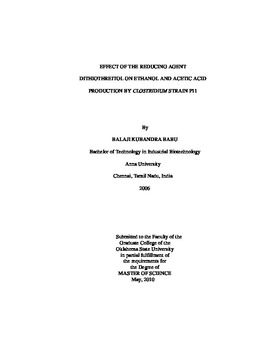| dc.contributor.advisor | Atiyeh, Hasan | |
| dc.contributor.author | Babu, Balaji Kubandra | |
| dc.date.accessioned | 2014-02-25T00:20:54Z | |
| dc.date.available | 2014-02-25T00:20:54Z | |
| dc.date.issued | 2010-05-01 | |
| dc.identifier.uri | https://hdl.handle.net/11244/7948 | |
| dc.description.abstract | The objective of this research is to investigate the effect of the reducing agent dithiothreitol (DTT) on enhancing ethanol production from synthesis gas (syngas) using Clostridium strain P11 in 250-mL serum bottles. Reducing agents help in regeneration of NADH from NAD+. NADH is utilized in the production of alcohol from aldehydes. The effect of DTT concentrations from 0 to 10 g/L was studied in 1.0 g/L yeast extract (YE) and 10 g/L corn steep liquor (CSL) media and with simulated syngas and producer gas. Syngas contains mainly carbon monoxide, hydrogen, carbon dioxide and nitrogen. The fermentation process was followed for 360 h. Liquid samples were collected every 24 h to determine cell mass, pH and product concentrations. The experiment was done in quadruplets at each DTT concentration and the results were analyzed for statistical significance using SASᆱ version 9.2 at 95% confidence level. Results showed that over 350% increase in ethanol concentration was obtained in media that contained at least 7.5 g/L of DTT in the 1.0 g/L yeast extract medium after 360 h of fermentation with simulated syngas compared to the control medium (without DTT). However, only a 35% increase in ethanol production was noticed in 10 g/L corn steep liquor media in the presence of 2.5 and 5.0 g/L of DTT compared to the control medium with simulated syngas. In addition, DTT (at a concentration of 2.5 g/L) produced about 240% more butanol in the 10 g/L CSL medium compared to the control with simulated syngas. The results suggested that the use of small concentrations of DTT in the broth enhances ethanol production from simulated syngas in YE media. When producer gas was used, DTT enhanced isopropanol production instead of ethanol production in both YE and CSL media. The electrons donated by DTT might have been utilized in the reduction of acetone to isopropanol by strain P11 instead of reduction of acetaldehyde to ethanol. The removal of acetone and other impurities from the producer gas could enhance DTT effectiveness as a reducing agent and improve ethanol production in both YE and CSL media. | |
| dc.format | application/pdf | |
| dc.language | en_US | |
| dc.publisher | Oklahoma State University | |
| dc.rights | Copyright is held by the author who has granted the Oklahoma State University Library the non-exclusive right to share this material in its institutional repository. Contact Digital Library Services at lib-dls@okstate.edu or 405-744-9161 for the permission policy on the use, reproduction or distribution of this material. | |
| dc.title | Effect of the Reducing Agent Dithiothreitol on Ethanol and Acetic Acid Production by Clostridium Strain P11 | |
| dc.type | text | |
| dc.contributor.committeeMember | Huhnke, Raymond L. | |
| dc.contributor.committeeMember | Wilkins, Mark R. | |
| dc.contributor.committeeMember | Bellmer, Danielle D. | |
| osu.filename | KubandraBabu_okstate_0664M_10884.pdf | |
| osu.college | Engineering, Architecture, and Technology | |
| osu.accesstype | Open Access | |
| dc.description.department | Biosystems and Agricultural Engineering | |
| dc.type.genre | Thesis | |
| dc.subject.keywords | clostridium strain p11 | |
| dc.subject.keywords | dithiothreitol | |
| dc.subject.keywords | ethanol | |
| dc.subject.keywords | producer gas | |
| dc.subject.keywords | reducing agent | |
| dc.subject.keywords | syngas | |
